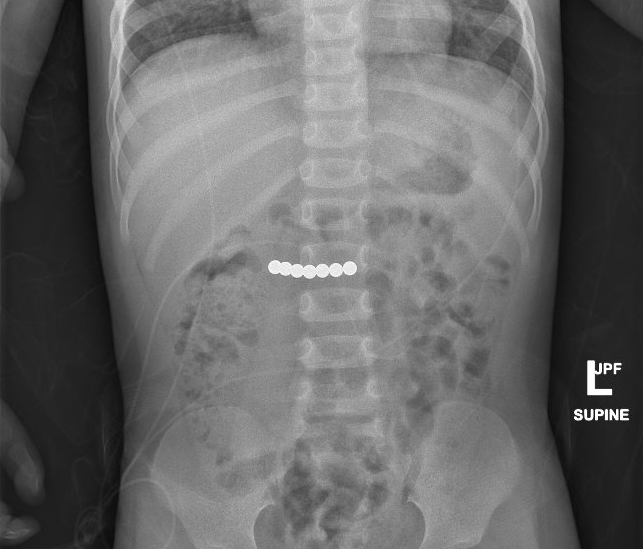Magnets have fascinated us for centuries, with the first magnet thought to have been discovered in ancient Greece about 4,000 years ago. Today is no different. Magnets intrigue adults and children alike. They are used in toys to provide a fun, interactive, educational, and imaginative experience. In the past few decades, rare earth magnets, which can be up to eight times stronger than the typical refrigerator magnet, have made their way into toys. If swallowed, they can place your child at risk for serious injury or even death.
In general, a single swallowed magnet does not tend to cause harm. However, when two or more magnets are swallowed, they can seriously damage internal organs. For example, a magnet in one part of the digestive tract will be attracted to another magnet or metallic object in a different part and adhere the two together through their strong force. This can lead to loss of blood blow, tissue death, and perforation – a hole in the intestines that allows contents to leak out, causing infection and potentially death.

X-ray showing rare earth magnets (the circular white objects) that have been swallowed and have magnetically adhered together within the intestinal tract. When the magnets stick together, they may pinch the child's bowel, which may cause a perforation (hole). That hole can leak stomach acid, food from the intestine, or stool into the abdomen, which can make the child extremely sick. Most magnet ingestions require some sort of surgical intervention.
The first report of a rare earth magnet ingestion was in 2002, and the number of reported ingestions steadily increased until 2014 when the Consumer Product Safety Commission (CPSC), a federal agency that monitors the safety of consumer products, banned these. However, that decision was overturned in 2016, and these rare earth magnets have made their way back onto the scene.
According to the CPSC, from 2009 to 2018, there were two deaths and approximately 45,00 magnet-related ingestions requiring hospital or emergency department treatment, mostly involving children 11 months to 16 years of age.
How to Keep Your Child Safe
The single most effective way to ensure you child does not ingest these high-powered magnets is through prevention -- keep them out of your home. Additional tips to prevent unnecessary injury include:
- Get rid of any rare earth magnets in your home, even if they are intended for adults
- Keep products with small parts, including magnets, out of reach and locked away from small children
- Directly supervise children whenever they are using magnets
- Never leave magnets out in the open – put them away as soon as you are done using them
- Keep a count of the number of magnets in a toy or play set
- Check for loose magnets that may become dislodged
Why Worry About Teenagers and Rare Earth Magnets
Teens have used rare earth magnets to create fake piercings in their noses or mouths, and those magnets can be accidentally swallowed or inhaled. When these strong magnets are used to create piercings on other parts of the body, such as the earlobes, they can pinch the skin and lead to local tissue damage.
Symptoms of Magnet Ingestion
Symptoms of magnet ingestion can include abdominal pain, nausea, vomiting, and diarrhea. Unfortunately, these symptoms are not unlike those of other common childhood illnesses, so parents may not realize their child has swallowed magnets until much later. This is another reason why it is important to keep magnets out of your home; or keep a count, always provide direct supervision, and store magnets away properly.
What to do if Your Child Swallowed a Magnet
If you suspect your child has swallowed a magnet, immediately contact your child’s pediatrician or proceed to the nearest Emergency Department. This is particularly important if your child needs Magnetic Resonance Imaging, also known as an MRI. MRIs use powerful magnet technology to capture images instead of radiation. Most magnet ingestions require some sort of surgical intervention. Delaying diagnosis and treatment can lead to serious injury or even death.
For More Information
For more information or to report an unsafe product, visit the Consumer Product Safety Commission’s site on magnets.
About the Author
Dr. Carmela Sosa has practiced pediatrics in both the urban and rural health settings – always focused on children with special healthcare needs and pediatric mental health. She joined Valley Children’s Charlie Mitchell Children’s Center in April 2012 to provide complex primary care to children of the Valley. Her roles expanded in 2016 to include Associate Program Director of the Valley Children’s Pediatric Residency Program, and again in 2019 to Medical Director of Valley Children’s Primary Care and Medical Director of the Guilds Center for Community Health.